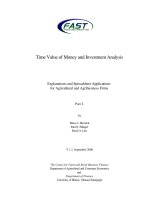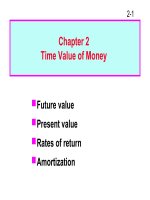Business finance ch 6 time value of money
Bạn đang xem bản rút gọn của tài liệu. Xem và tải ngay bản đầy đủ của tài liệu tại đây (475.34 KB, 44 trang )
CHAPTER 6
Time Value of Money
Future value
Present value
Annuities
Rates of return
Amortization
6-1
Time lines
0
1
2
3
CF1
CF2
CF3
i%
CF0
Show the timing of cash flows.
Tick marks occur at the end of periods,
so Time 0 is today; Time 1 is the end
of the first period (year, month, etc.)
or the beginning of the second period.
6-2
Drawing time lines:
$100 lump sum due in 2 years;
3-year $100 ordinary annuity
$100 lump sum due in 2
years
0
1
2
i%
100
3 year $100 ordinary
annuity
0
1
2
3
100
100
i%
100
6-3
Drawing time lines:
Uneven cash flow stream; CF0 = $50,
CF1 = $100, CF2 = $75, and CF3 =
Uneven cash flow stream
$50
0
1
2
3
100
75
50
i%
-50
6-4
What is the future value (FV) of an
initial $100 after 3 years, if I/YR =
10%?
0
Finding the FV of a cash flow or series
of cash flows when compound interest
is applied is called compounding.
FV can be solved by using the
arithmetic, financial calculator, and
spreadsheet methods.
1
2
3
10%
100
FV = ?
6-5
Solving for FV:
The arithmetic method
After 1 year:
FV1 = PV ( 1 + i ) = $100 (1.10)
= $110.00
After 2 years:
FV2 = PV ( 1 + i )2 = $100 (1.10)2
=$121.00
After 3 years:
FV3 = PV ( 1 + i )3 = $100 (1.10)3
=$133.10
After n years (general case):
FVn = PV ( 1 + i )n
6-6
Solving for FV:
The calculator method
Solves the general FV equation.
Requires 4 inputs into calculator, and
will solve for the fifth. (Set to P/YR =
1 and END mode.)
INPUTS
OUTPUT
3
10
-100
0
N
I/YR
PV
PMT
FV
133.10
6-7
What is the present value (PV) of
$100 due in 3 years, if I/YR = 10%?
Finding the PV of a cash flow or series
of cash flows when compound interest
is applied is called discounting (the
reverse of compounding).
The PV shows the value of cash flows
in terms of today’s purchasing power.
0
1
2
3
10%
PV = ?
100
6-8
Solving for PV:
The arithmetic method
Solve the general FV equation for PV:
PV = FVn / ( 1 + i )n
PV = FV3 / ( 1 + i )3
= $100 / ( 1.10 )3
= $75.13
6-9
Solving for PV:
The calculator method
Solves the general FV equation for PV.
Exactly like solving for FV, except we
have different input information and
are solving for a different variable.
INPUTS
OUTPUT
3
10
N
I/YR
PV
0
100
PMT
FV
-75.13
6-10
Solving for N:
If sales grow at 20% per year, how
long before sales double?
Solves the general FV equation for N.
Same as previous problems, but now
solving for N.
INPUTS
N
OUTPUT
20
-1
0
2
I/YR
PV
PMT
FV
3.8
6-11
What is the difference between
an ordinary annuity and an
annuity due?
Ordinary Annuity
0
i%
Annuity Due
0
PMT
i%
1
2
3
PMT
PMT
PMT
1
2
3
PMT
PMT
6-12
Solving for FV:
3-year ordinary annuity of $100 at
10%
$100 payments occur at the end
of each period, but there is no PV.
INPUTS
OUTPUT
3
10
0
-100
N
I/YR
PV
PMT
FV
331
6-13
Solving for PV:
3-year ordinary annuity of $100 at
10%
$100 payments still occur at the end
of each period, but now there is no
FV.
INPUTS
OUTPUT
3
10
N
I/YR
PV
100
0
PMT
FV
-248.69
6-14
Solving for FV:
3-year annuity due of $100 at 10%
Now, $100 payments occur at the
beginning of each period.
Set calculator to “BEGIN” mode.
INPUTS
OUTPUT
3
10
0
-100
N
I/YR
PV
PMT
FV
364.10
6-15
Solving for PV:
3 year annuity due of $100 at 10%
Again, $100 payments occur at the
beginning of each period.
Set calculator to “BEGIN” mode.
INPUTS
OUTPUT
3
10
N
I/YR
PV
100
0
PMT
FV
-273.55
6-16
What is the PV of this uneven
cash flow stream?
0
1
2
3
4
100
300
300
-50
10%
90.91
247.93
225.39
-34.15
530.08 = PV
6-17
Solving for PV:
Uneven cash flow stream
Input cash flows in the calculator’s
“CFLO” register:
CF0 = 0
CF1 = 100
CF2 = 300
CF3 = 300
CF4 = -50
Enter I/YR = 10, press NPV button to
get NPV = $530.09. (Here NPV = PV.)
6-18
Solving for I:
What interest rate would cause $100
to grow to $125.97 in 3 years?
Solves the general FV equation for I.
INPUTS
3
N
OUTPUT
I/YR
-100
0
125.97
PV
PMT
FV
8
6-19
The Power of Compound
Interest
A 20-year-old student wants to start saving for
retirement. She plans to save $3 a day. Every
day, she puts $3 in her drawer. At the end of
the year, she invests the accumulated savings
($1,095) in an online stock account. The stock
account has an expected annual return of
12%.
How much money will she have when she is 65
years old?
6-20
Solving for FV:
Savings problem
If she begins saving today, and
sticks to her plan, she will have
$1,487,261.89 when she is 65.
INPUTS
OUTPUT
45
12
0
-1095
N
I/YR
PV
PMT
FV
1,487,262
6-21
Solving for FV:
Savings problem, if you wait until
you are 40 years old to start
If a 40-year-old investor begins saving today,
and sticks to the plan, he or she will have
$146,000.59 at age 65. This is $1.3 million
less than if starting at age 20.
Lesson: It pays to start saving early.
INPUTS
OUTPUT
25
12
0
-1095
N
I/YR
PV
PMT
FV
146,001
6-22
Solving for PMT:
How much must the 40-year old
deposit annually to catch the 20year
old?
To find the required annual
contribution, enter the number of
years until retirement and the final
goal of $1,487,261.89, and solve for
PMT.
INPUTS
OUTPUT
25
12
0
N
I/YR
PV
1,487,262
PMT
FV
-11,154.42
6-23
Will the FV of a lump sum be larger
or smaller if compounded more
often, holding the stated I%
constant?
LARGER, as the more frequently
compounding occurs, interest is earned on
0 interest more
1 often.
2
3
10%
100
0
0
100
Annually: FV3 = $100(1.10)3 = $133.10
5%
1
1
2
3
2
4
5
Semiannually: FV6 = $100(1.05)6 = $134.01
133.10
3
6
134.01
6-24
Classifications of interest
rates
Nominal rate (iNOM) – also called the
quoted or state rate. An annual rate that
ignores compounding effects.
iNOM is stated in contracts. Periods must also be given, e.g. 8%
Quarterly or 8% Daily interest.
Periodic rate (iPER) – amount of interest
charged each period, e.g. monthly or
quarterly.
iPER = iNOM / m, where m is the number of compounding periods per
year. m = 4 for quarterly and m = 12 for monthly compounding.
6-25









